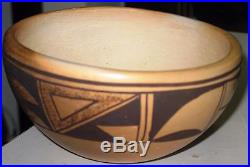
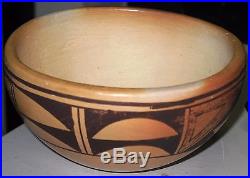
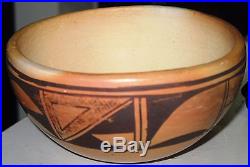
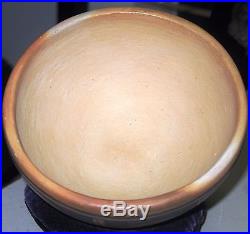
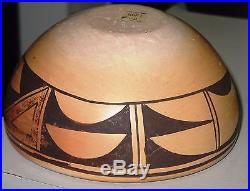
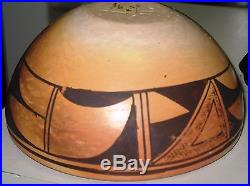
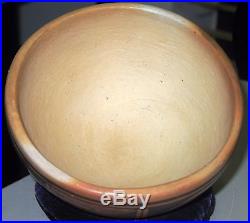
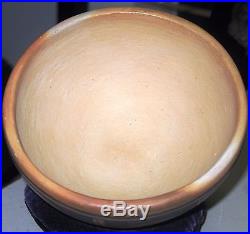
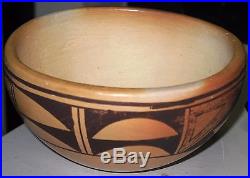

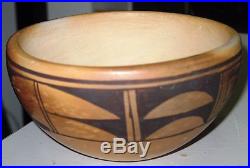
Check out my other items. Tribe: Hopi Artist: Unknown Pottery Construction: Hand Coiled Type of Pottery: Firing Method: Kiln Fired. Condition: Good; surface wear from age and use Materials: clay Size: 5.125″ W x 2.75″ H Color/Finish: tan/brown/russet from estate storage a vintage Hopi pottery bowl, Hopi polychrome hand-coiled bowl with traditional polychrome decoration with traditional geometric Hopi design. In all aspects of Hopi ritual, ideas of space, time, color, and number are all interrelated in such a way as to provide order to the Hopi world. This is true for Hopi pottery making. It has been suggested that the golden yellow Hopi pottery may have been the inspiration for tales of wealth which lured the early Spaniards to the Seven Cities of Cibola, since to people who did not refine precious metals, gold could have referred to the color. Francisco Porras and two other padres came to the Hopi villages to stay, marking the beginning of the Mission period which brought many changes in Hopi life and even influenced the pottery in the half-century of its duration. With the establishment of the missions sheep were introduced to the Hopi. Very soon after, pottery was being fired with sheep dung for fuel as it is to this day. The use of coal as a source of heat, for cooking and for firing pottery was abandoned. Pottery became thicker and heavier than it had been, shapes reverted to the pre-Sikyatki hemispherical bowls and globular jars, and painted decoration was confined to geometric designs as before. The tradition of a yellow ware with black and black and red painted designs continued, and the vessels were thinner and better fired than in Mission times. This was the status of Hopi ceramic art when Americans began to come to the villages in the 1870′s and 1880′s. Although First Mesa is the most well-known for its pottery, Hopi potters can be found throughout the Hopi mesas. All authentic Hopi pottery is handmade by the coil and scrape technique. Hopi potters do not use a pottery wheel or make mold-poured pottery. They use the same techniques as their ancestors, hand-painting the designs with yucca leaf brush. The Hopi call their ancestors, Hisatsinom, People of Long Ago. ” The public and most anthropologists refer to these people as the “Anasazi, a word that has become popular in the general literature. Early Hisatsinom are called the Basketmaker people. The Basketmakers were a hunting and gathering people who became increasingly sedentary as their reliance on agriculture increased. As early as A. 700, the Basketmaker people began making plain pottery. Increased corn-based agriculture and increased occupation of multi-roomed pueblo dwellings was accompanied by an increase in the quantity and variety of pottery manufactured by these people. From Pueblo I through early Pueblo III A. 800 to 1300, pottery with black painted designs on white slip was being made everywhere in the Pueblo world. The culmination of the Hopi polychromes was Sikyatki Polychrome, which flourished from A. Later polychrome in the Hopi area included Payupki, Walpi, Polacca, and San Bernardo types. In the late 1800s, outsiders became interested in Hopi pottery, and a revival in pottery production was sparked by the work of Nampeyo and other First Mesa potters. They reproduced the beautiful Sikyatki Polychrome styles and handed down their skills. Most contemporary pottery is made on First Mesa. Located in Northern Arizona atop three large mesas are the Hopi pueblos. Surrounded by the Navajo Reservation, Hopi consists of three Mesas, and each Mesa has several villages. On First Mesa there is a long tradition of pottery making that was ultimately shaped by the master potter Nampeyo at the turn of the 20th century. Nampeyo is credited with the revival of a prehistoric Hopi pottery type named Sikyatki after an archaeological site near First Mesa. In addition to the distinct designs that Nampeyo revived, Hopi pottery is also known for its wonderful blushes. The blushes are created by a combination of the natural iron rich clay and the pit firing technique. It is the tonal yellow to dark orange surface of Hopi pottery that distinguishes it from the other Pueblos. The Hopi-Tewa speaking people are primarily located on First Mesa in the villages of Hano and Polacca. They are descendants of the Tewa speaking Pueblo people of New Mexico who came to Hopi around the time of the Pueblo Revolt in 1680. It is the Hopi-Tewa group who are best known for their pottery, especially the revival pottery of the ancient Sikyatki ruin near the base of First Mesa. Modern Hopi potters make their pottery in the traditional manner. The clay is hand dug on the Hopi mesas and hand processed. The pots are carefully hand constructed using the coil and scrape techniques their ancestors taught them. The paints used are from naturally occurring materials. For example, black paint is made by boiling Beeweed for a long time until it becomes very dark and thick. It is then dried into little cakes which are wrapped in corn husk until ready for use. It is called guaco. The intricate and beautiful designs are painted free hand using a yucca leaf brush. The pots are then fired in the open air out on the mesa using sheep dung and cedar as a heat source. Prehistoric potters did not have domestic animals to provide dung, but modern potters prefer it for its rapid, even heat. Some Hopi pottery is ceremonial in nature and not intended for public consumption. You will not find this kind of pottery for sale in reputable galleries and shops. Most prehistoric pottery has been taken from burial contexts, and the Hopi people find non-Hopi ownership of these pots offensive. 1 of hundreds of personal collectibles plus items from my metaphysical bookstore I recently closed, plus books, tarot, videos, jewelry, gifts and more. Try me you’ll love me! We do not mark merchandise values below value or mark items as “gifts” – US and International government regulations prohibit such behavior. I offer discounts for multiple orders by combining charges depending on weight. Even if an invoice was generated I can always re-issue a corrected one. International orders can go first class parcel if you dont mind the wait or I can send them Priority but for heavy, larger items it can be expensive! Depending on the weight of the pieces, many can be combined for the same rate. Books, CD’s, etc. Feedback will be given after you receive the item and you are satisfied by leaving feedback for me. So we both can be happy. My goal, as it was in my store for over 25 years, is to maintain happy satisfied customers that will return and become regular purchasers on my site. I strive to be an honest businessman and try to make everyone happy. My philosophy is if you offer a great item at a good, fair price you will get repeat customers. Depending on the condition, availability, rarity and wholesale cost I will entertain any reasonable offer or counter with one that I feel is reasonable and why. Give it a shot and see how it works! The item “VINTAGE HOPI Pottery Bowl 1940′s 50′s HAND MADE, PAINTED POLYCHROME DESIGN” is in sale since Sunday, November 01, 2015. This item is in the category “Collectibles\Cultures & Ethnicities\Native American\ US\1935-Now\Pottery”. The seller is “chesproperties” and is located in Fort Lauderdale, Florida. This item can be shipped worldwide.
- Country/Region of Manufacture: United States
- Artisan: UNKNOWN
- Origin: ESTATE COLLECTION
- Tribal Affiliation: HOPI
- Region: ARIZONA
- Featured Refinements: Hopi Pottery